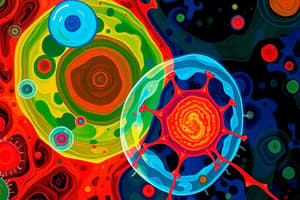Podcast
Questions and Answers
What process allows cells to maintain their internal environment despite external stress?
What process allows cells to maintain their internal environment despite external stress?
- Adaptation
- Cell death
- Cell injury
- Homeostasis (correct)
Which of the following best defines reversible injury in cells?
Which of the following best defines reversible injury in cells?
- Genetic mutation without effects
- Irreversible changes in cell structure
- Permanent cell death
- Restoration of normal function when stress is removed (correct)
What is a common cause of cell injury related to oxygen supply?
What is a common cause of cell injury related to oxygen supply?
- Hypoxia and ischemia (correct)
- Toxins in medication
- Age-related changes
- Nutritional imbalance
How do toxins typically contribute to cell injury?
How do toxins typically contribute to cell injury?
Which of the following is NOT considered a physical agent that can cause cell injury?
Which of the following is NOT considered a physical agent that can cause cell injury?
Which factor primarily impacts the ability of cells to respond to stress as they age?
Which factor primarily impacts the ability of cells to respond to stress as they age?
What mechanism is employed by cells to deal with impaired function during reversible injury?
What mechanism is employed by cells to deal with impaired function during reversible injury?
Which of the following conditions is related to genetic abnormalities causing cell injury?
Which of the following conditions is related to genetic abnormalities causing cell injury?
What is one of the primary morphological changes observed in reversible injury?
What is one of the primary morphological changes observed in reversible injury?
Which option describes a characteristic of cellular edema?
Which option describes a characteristic of cellular edema?
What does hypoxic hypoxia result from?
What does hypoxic hypoxia result from?
Which of the following represents a mechanism of cell injury due to hypoxia?
Which of the following represents a mechanism of cell injury due to hypoxia?
What is a consequence of anaerobic glycolysis during hypoxia?
What is a consequence of anaerobic glycolysis during hypoxia?
How does ischemic hypoxia occur?
How does ischemic hypoxia occur?
What might occur in cells during reversible injury that indicates damage but does not lead to cell death?
What might occur in cells during reversible injury that indicates damage but does not lead to cell death?
What happens to cell function following injury despite morphological changes being undetected?
What happens to cell function following injury despite morphological changes being undetected?
Flashcards
Hypoxia
Hypoxia
A lack of oxygen in the tissues.
Reversible Injury
Reversible Injury
A state of cell injury where impaired function and morphology can return to normal when the negative factors are removed.
Homeostasis
Homeostasis
The maintenance of the internal environment of the cell within acceptable limits.
Ischemia
Ischemia
Signup and view all the flashcards
Physical Agents
Physical Agents
Signup and view all the flashcards
Infectious Agents
Infectious Agents
Signup and view all the flashcards
Toxins
Toxins
Signup and view all the flashcards
Immunological Reactions
Immunological Reactions
Signup and view all the flashcards
Hypoxic Hypoxia
Hypoxic Hypoxia
Signup and view all the flashcards
Anemic Hypoxia
Anemic Hypoxia
Signup and view all the flashcards
Histotoxic Hypoxia
Histotoxic Hypoxia
Signup and view all the flashcards
Stagnant Hypoxia
Stagnant Hypoxia
Signup and view all the flashcards
Cellular Edema
Cellular Edema
Signup and view all the flashcards
Fatty Changes
Fatty Changes
Signup and view all the flashcards
Study Notes
Cell Injury
- Cell injury is a process in which cells are damaged.
- The response to injury depends on the type, duration, and severity of the injury.
- The response depends on the type of cell, the cell's adaptive capacity, and the cell's genetic composition.
- Cells experience functional and biochemical abnormalities.
- Cell function is lost before biochemical and morphological changes are visible.
Introduction
- Body cells adapt to their environment.
- Homeostasis is the maintenance of a stable internal environment within acceptable limits.
- Cells adapt to physical stress (increased workload), or harmful conditions (nutrient deficiency).
- Cells maintain viability and function after adapting.
- Cell injury occurs when the capacity to adapt or stress exceeds a certain level.
- Cell injury can be reversible; cells can return to their original state.
- Irreversible injury occurs with prolonged exposure to stressors; the cell dies.
- Cell death is a normal and significant process in embryogenesis, organ development, and maintenance of homeostasis.
Causes of Cell Injury
- Hypoxia and Ischemia:
- Hypoxia is reduced oxygen supply below physiological levels.
- Ischemia is a reduced blood supply.
- They are common causes of cell injury.
- Toxins:
- Found in the environment (carbon dioxide, smoke, alcohol, drugs).
- Some medicine at therapeutic dosages can damage cells and tissues.
- All viruses, bacteria, fungi, and protozoa can damage cells.
- Physical agents:
- Trauma, high temperatures, radiation, electric current.
- Changes in atmospheric pressure can damage cells.
- Immunological Reactions:
- Autoimmune reactions and allergic reactions damage cells.
- Genetic Abnormalities:
- Deficiencies in functional proteins can damage cells.
- Nutritional Imbalances:
- A major cause of cell injury.
- Aging:
- Reduces a cell's ability to respond to stress and can lead to cell death.
Reversible Injury
- Reversible injury is a stage where impaired cell function and morphology can be eliminated if the harmful stimuli are removed.
- Cells and intracellular organelles generally swell due to water absorption.
- Cell homeostasis is disrupted during reversible injury.
Morphological Changes in Reversible Injury
- Cellular edema: clearly visible at the organ level. Paleness, increased turgor, and increased organ mass are observed during macroscopic examination. Small vacuoles are visible in the cytoplasm under a microscope.
- Fatty changes: occur in the cytoplasm of cells.
- Other changes include: increased redness of the cytoplasm, plasma membrane swelling, weakening of intercellular connections, accumulation of chromatin, and amorphous formations (myelin figures - aggregations of phospholipids).
General Principles of Cell Injury
- Cellular response to injury depends on the type, duration, and severity of the injury.
- The outcome of exposure depends on the cell type, its adaptive capacity, and its genetic makeup.
- Cell injury typically arises from functional and biochemical abnormalities within one or more major cellular components.
- Cell function often declines before detectable biochemical or morphological signs of injury appear.
Mechanism of Cell Injury (Hypoxia and Ischemia)
- Hypoxia is a decrease in oxygen supply to tissues below normal levels.
- A critical and common cause of cell injury and death.
- Reduced ATP production.
- Failure of Na+-K+ pumps.
- Glycolysis increases; lactic acid and inorganic phosphates accumulate.
- Protein synthesis decreases; lipids accumulate.
- All of these changes are reversible if the oxygen supply is restored.
Mechanism of Cell Injury (Toxins)
- Toxins cause cell injury through distinct mechanisms.
- Some toxins directly bind to crucial molecular components or organelles.
- Other toxins transform into reactive metabolites that affect cells.
Types of Hypoxia
- Anemic: decreased blood oxygen due to low hemoglobin (e.g., hemolytic anemia).
- Histotoxic: impaired oxygen use by tissues (e.g., carbon monoxide poisoning)
- Hypoxic (or ischemia): insufficient oxygen supply to the blood (e.g., drowning).
- Ischemic: reduced blood supply to cells.
- Stagnant: insufficient blood supply (e.g., circulatory failure).
Studying That Suits You
Use AI to generate personalized quizzes and flashcards to suit your learning preferences.




